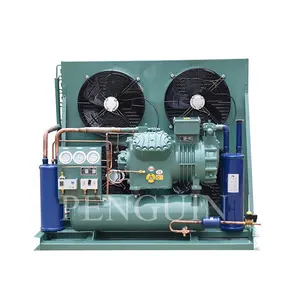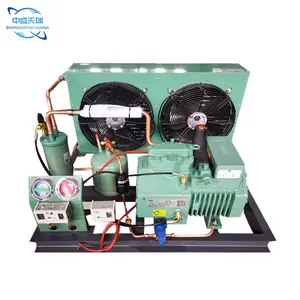(32423 products available)























































































































































































































































Cool room refrigeration equipment is used to cool food items, beverages, and other goods in commercial cool rooms. The refrigeration equipment is available in different types, each suitable for specific business needs and setup.
A split system consists of an indoor evaporator unit and an outdoor condenser unit. These two units are connected by refrigerant lines. The indoor unit cools the air within the cool room, while the outdoor unit releases heat. Split systems are ideal for medium to large cool rooms. They are also suitable for businesses that do not want noise disturbances within their premises.
Self-contained refrigeration systems have all the components of a refrigeration system in one unit. These components include the compressor, condenser, evaporator, and a fan. Self-contained systems are compact and easy to install. They are suitable for small to medium-sized cool rooms. The systems are also ideal for businesses on a budget.
In remote refrigeration systems, the condenser and compressor are located outside the building. The system is connected to the evaporator in the cool room by refrigerant lines. Remote refrigeration systems are suitable for eliminating noise within the building. They are also ideal for large commercial setups. Remote refrigeration systems are energy efficient.
An absorption refrigeration system uses a heat source to power the system. The heat source can be waste heat, gas, or a low-temperature heat source. Absorption refrigeration systems are energy efficient and have low operational costs. They are suitable for businesses that have access to alternative energy sources.
Modular refrigeration systems consist of individual refrigeration modules. Business owners can add or remove modules to increase or decrease the cooling capacity. The system also provides redundancy. If one module fails, the other modules will continue to operate. Modular refrigeration systems are suitable for large cool rooms and those with fluctuating cooling needs.
Proper maintenance is vital to the performance, longevity, and energy efficiency of walk-in coolers. Here are some general care tips for a walk-in cooler and freezer:
The cold room refrigeration equipment is widely applicable in various industries and applications, as follows:
As the core of the refrigeration unit for cold storage, the refrigeration equipment provides a cool environment for perishable food, maintaining their freshness and extending their shelf life. It is commonly used in large-scale cold storage, refrigerated warehouses, and refrigerated logistics centers for refrigerating frozen foods, fresh produce, and other temperature-sensitive items.
In restaurants, catering companies, and central kitchens, refrigerator equipment for cold rooms is used to store, preserve, and prepare food. It is used in refrigerated rooms and walk-in refrigerators to store perishable ingredients, semi-finished products, and prepared food. Therefore, the cold storage chiller unit has the functions of refrigeration, preservation, and freshness, and it can also ensure the quality of the food.
In hospitals, laboratories, and pharmaceutical companies, cold rooms refrigeration equipment is used to store temperature-sensitive drugs, vaccines, blood products, and biological samples. With a precise temperature control system, it maintains constant temperature and humidity within the required range to ensure the efficacy and safety of medical supplies.
The refrigeration equipment of the cold room is used in scientific research institutions and laboratories to store and preserve biological samples, reagents, and experimental materials. Its stable temperature control and humidity regulation features ensure the accuracy and reliability of research and testing.
Supermarkets, convenience stores, and retail stores commonly use cold room chillers to store and display perishable products such as fresh meat, dairy products, fruits, and vegetables. The refrigeration equipment for the cold room can attract customers, increase sales, and maintain product quality through the visual display.
Hotels, resorts, and banquet venues may use cold storage chiller unit for storing beverages, including wine, beer, and soft drinks. The refrigeration equipment for the cold room to keep beverages at the perfect serving temperature and ensure guests' satisfaction.
Greenhouses, nurseries, and agricultural facilities may use mobile cold room refrigeration units to store and preserve flowers, plants, and agricultural produce. The refrigeration equipment for the cold room to extend the harvest season and maintain product quality.
It is a crucial decision for business owners to choose the right cool room refrigeration equipment for their commercial needs. Several factors need to be considered when selecting the cool room equipment to ensure that they are properly sized, sufficiently efficient, and compliant with relevant standards and regulations.
Q1: What is the future of refrigeration equipment?
A1: The future of refrigeration equipment lies in the ongoing development of sustainable solutions. Emerging technologies like magnetic refrigeration, solid-state refrigeration, and natural refrigerants are gaining traction for their potential to reduce environmental impact.
Q2: What are the trends reshaping the refrigeration industry?
A2: Some key trends reshaping the refrigeration industry include the growing demand for energy-efficient systems, the increasing popularity of natural refrigerants, and the integration of smart technologies for enhanced monitoring and control.
Q3: What is driving the demand for energy-efficient refrigeration equipment?
A3: The demand for energy-efficient refrigeration equipment is driven by increasing awareness of environmental sustainability, stringent energy regulations, and the desire to reduce operating costs. Businesses are looking for refrigeration solutions that minimize energy consumption without compromising performance.
Q4: What are the benefits of energy-efficient refrigeration equipment?
A4: Energy-efficient refrigeration equipment offers numerous benefits, including lower utility bills, reduced carbon footprint, extended equipment lifespan, improved temperature stability, and better system reliability. Investing in energy-efficient refrigeration equipment yields long-term savings and environmental advantages.